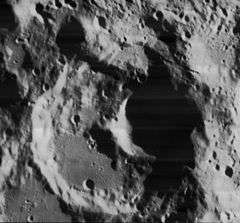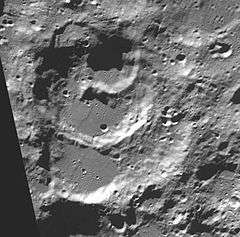Newton (lunar crater)
Newton is a lunar impact crater located near the south limb of the Moon. It is south-southwest of the crater Moretus. To the northeast is Short, and in the northwest are Casatus and Klaproth. Because of its location, the crater appears highly oblong due to foreshortening. It is considered the deepest crater on the near side of the Moon.
 Lunar Orbiter 4 image | |
| Coordinates | 76.7°S 16.9°W |
|---|---|
| Diameter | 79 km |
| Depth | 6.1 km |
| Colongitude | 18° at sunrise |
| Eponym | Isaac Newton |

The interior of Newton is a picture in contrasts. The southern end has been covered, possibly by lava flows or ejecta, leaving a relatively flat surface that is marked only by tiny craters and a slight wrinkle ridge down the middle. The northern half is rugged and irregular, with the satellite crater Newton D overlying the north-northeastern rim and extending across nearly half the crater diameter.
The rim in the south is relatively low and narrow, with the smaller crater Newton G partly overlain and flooded by lava. This adjacent crater forms a step up from the interior of Newton, and there is a tiny rille in the south floor of Newton where it appears as if a channel flowed down the side from Newton G. The other parts of the outer crater wall are much wider than in the south end, particularly in the areas adjacent to Newton D.
Satellite craters
By convention these features are identified on lunar maps by placing the letter on the side of the crater midpoint that is closest to Newton.
| Newton | Latitude | Longitude | Diameter |
|---|---|---|---|
| A | 79.7° S | 19.7° W | 64 km |
| B | 81.1° S | 15.4° W | 44 km |
| C | 74.8° S | 14.4° W | 35 km |
| D | 75.9° S | 14.8° W | 37 km |
| E | 79.8° S | 36.9° W | 17 km |
| F | 72.2° S | 16.1° W | 7 km |
| G | 78.2° S | 18.3° W | 67 km |
References
- Wood, Chuck (2005-08-06). "Sliced in Half". Lunar Photo of the Day. Retrieved 2006-07-21.
- Andersson, L. E.; Whitaker, E. A. (1982). NASA Catalogue of Lunar Nomenclature. NASA RP-1097.CS1 maint: ref=harv (link)
- Blue, Jennifer (July 25, 2007). "Gazetteer of Planetary Nomenclature". USGS. Retrieved 2007-08-05.CS1 maint: ref=harv (link)
- Bussey, B.; Spudis, P. (2004). The Clementine Atlas of the Moon. New York: Cambridge University Press. ISBN 978-0-521-81528-4.CS1 maint: ref=harv (link)
- Cocks, Elijah E.; Cocks, Josiah C. (1995). Who's Who on the Moon: A Biographical Dictionary of Lunar Nomenclature. Tudor Publishers. ISBN 978-0-936389-27-1.CS1 maint: ref=harv (link)
- McDowell, Jonathan (July 15, 2007). "Lunar Nomenclature". Jonathan's Space Report. Retrieved 2007-10-24.CS1 maint: ref=harv (link)
- Menzel, D. H.; Minnaert, M.; Levin, B.; Dollfus, A.; Bell, B. (1971). "Report on Lunar Nomenclature by the Working Group of Commission 17 of the IAU". Space Science Reviews. 12 (2): 136–186. Bibcode:1971SSRv...12..136M. doi:10.1007/BF00171763.CS1 maint: ref=harv (link)
- Moore, Patrick (2001). On the Moon. Sterling Publishing Co. ISBN 978-0-304-35469-6.CS1 maint: ref=harv (link)
- Price, Fred W. (1988). The Moon Observer's Handbook. Cambridge University Press. ISBN 978-0-521-33500-3.CS1 maint: ref=harv (link)
- Rükl, Antonín (1990). Atlas of the Moon. Kalmbach Books. ISBN 978-0-913135-17-4.CS1 maint: ref=harv (link)
- Webb, Rev. T. W. (1962). Celestial Objects for Common Telescopes (6th revised ed.). Dover. ISBN 978-0-486-20917-3.CS1 maint: ref=harv (link)
- Whitaker, Ewen A. (1999). Mapping and Naming the Moon. Cambridge University Press. ISBN 978-0-521-62248-6.CS1 maint: ref=harv (link)
- Wlasuk, Peter T. (2000). Observing the Moon. Springer. ISBN 978-1-85233-193-1.CS1 maint: ref=harv (link)